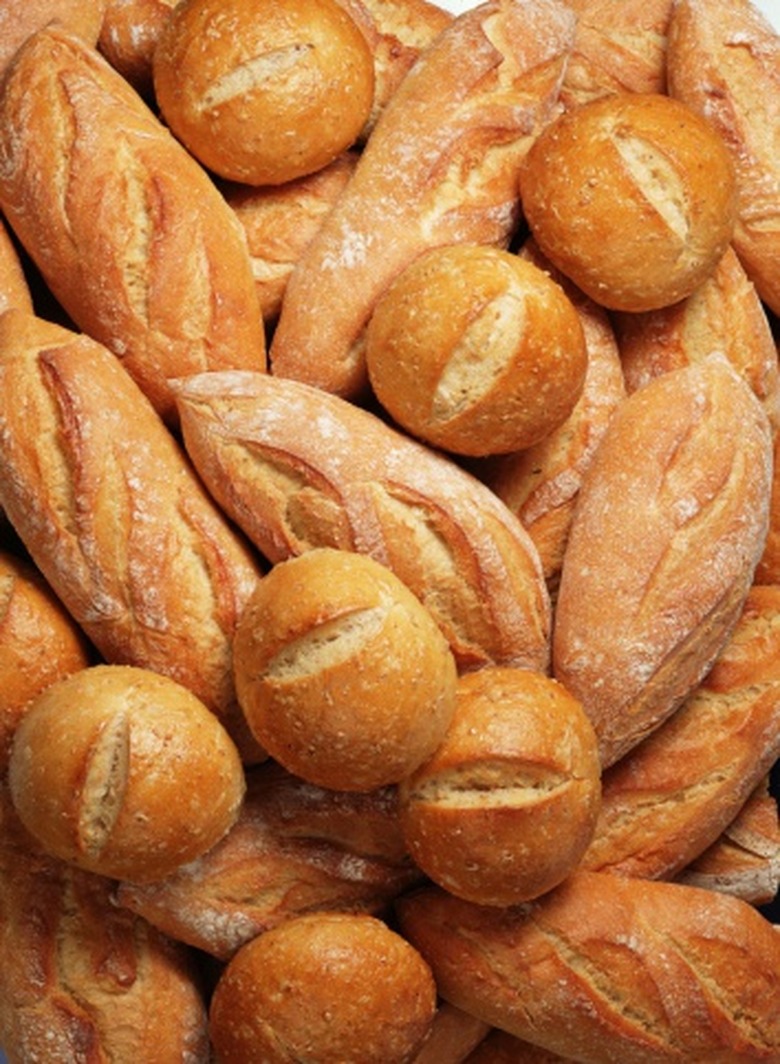What Is The Phylum Of Bread Mold?
The taxonomy, or scientific classification, of bread molds defines the behavior and genetics of mold species. As many as 100,000 species of mold exist. These fungi appear on everything from bathroom walls to food. The visible components of molds constitute colonies of fungal spores, which serve the same purpose in fungi as seeds do in plants. Various species of molds appear on bread. These species belong to a number of genera and more than one phylum.
Bread Molds
Bread Molds
Black bread mold (Rhizopus stolonifer) occurs on a variety of hosts. The mold requires sugar and starch to grow. Commonly found on breads, this diverse and adaptable mold species also appears on a number of fruit species, birds nests, decaying litter and even sand. Many other common bread molds belong to the Penicillium or Epenicillium genus. Species of this genus are among the most common molds on all manner of hosts, including bread, soil, decaying vegetation and building materials. Other mold genera appearing on bread include Aspergillus/Neosartorya, Mucor or Rhizomucor.
Bread Mold Phyla
Bread Mold Phyla
Bread molds belong to various phyla. Black bread mold and other species of the Rhizopus that occur on bread belong to the Zygomycota phylum, as do bread molds of the Rhizomucor genus. Aspergillus/Neosartorya and Penicillium molds belong to the Ascomycota, or sac fungi, phylum. Molds of the Mucor genus, known as slimy molds, belong to the Myxomycota phylum. Some sources, such as the Integrated Taxonomic Information System (ITIS), categorize this phylum as a fungus. Others consider it part of the Protoctista kingdom, which includes all organisms not categorized as plants, animals, fungi or prokaryotes.
More on Bread Mold Taxonomy
More on Bread Mold Taxonomy
All phyla of bread mold, with the possible exception of Myxomycota, belong to the Kingdom Fungi. The Fungi kingdom exhibits incredible diversity. Organisms of the kingdom run the gamut from mushrooms to mold to species of ringworm. Fungal species of ringworm produce no actual worm but cause symptoms identified by humans as ringworm.
ITIS identifies 27 families and 10 orders of organisms belonging to the Ascomycota phylum. These species form organisms, such as morel mushrooms, molds and lichen, a moss-like substance. Bread molds are defined at the level of genus. This means they bear genetic relationships, through the categories of Phylum, Family, Order and Class, to a variety of fungal forms of life, rather than belonging to a single category defining nothing other than bread molds.
Classifying Bread Mold by Phylum
Classifying Bread Mold by Phylum
Scientists define the phyla of the Fungi kingdom by modes of sexual reproduction. If scientists know little or nothing about the reproductive process of a species of fungi, such as a bread mold, that species falls into the Deuteromycota phylum. As the scientific community learns more about reproduction in these species, it assigns the species to another phylum of the Fungi kingdom based on its reproductive habits. All fungi follow the same basic reproductive pattern, which involves the division of spores through meiosis. The specifics of this process, however, differ in details. The differing natures of bread mold reproduction help scientists classify them by phyla.
Cite This Article
MLA
Gish, Will. "What Is The Phylum Of Bread Mold?" sciencing.com, https://www.sciencing.com/what-is-the-phylum-of-bread-mold-13421396/. 21 July 2017.
APA
Gish, Will. (2017, July 21). What Is The Phylum Of Bread Mold?. sciencing.com. Retrieved from https://www.sciencing.com/what-is-the-phylum-of-bread-mold-13421396/
Chicago
Gish, Will. What Is The Phylum Of Bread Mold? last modified March 24, 2022. https://www.sciencing.com/what-is-the-phylum-of-bread-mold-13421396/
